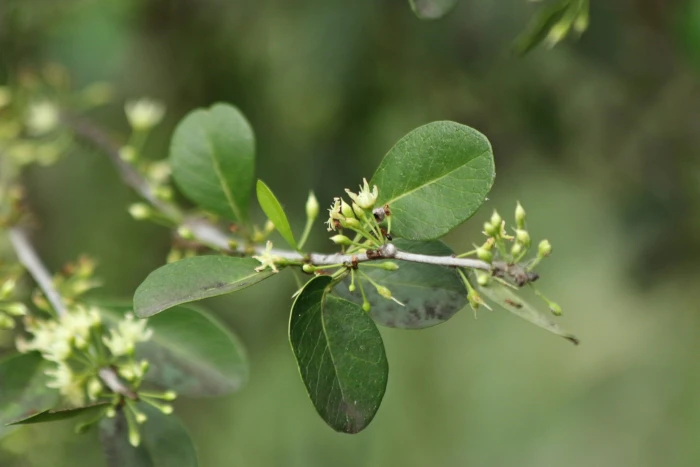Saffron Plum
(Sideroxylon celastrinum)
Saffron Plum (Sideroxylon celastrinum)
/
/

Juan Chavez
CC BY 4.0
Image By:
Juan Chavez
Recorded By:
Copyright:
CC BY 4.0
Copyright Notice:
Photo by: Juan Chavez | License Type: CC BY 4.0 | License URL: http://creativecommons.org/licenses/by/4.0/ | Rights Holder: Juan Chavez | Publisher: iNaturalist | Date Created: 2017-11-02T10:06:16-07:00 |


















































Estimated Native Range
Climate Requirements for Noblesville, Indiana
| This Plant | Your Site | Plant Suitability for Your Location | ||
|---|---|---|---|---|
| • Precipitation | 10" - 182" | 38" | Aquatic | Aquatic |
| • High Temp. | 74°F - 103°F | 85°F | Your summer temperatures are normal for this plant. | Excellent |
| • Low Temp. | 32°F - 75°F | 17°F | Your winter temperatures may be too cold for this plant | Too cold |
This plant should grow well at your location with about N inches per year (Y minutes per month) of irrigation.
Summary
Sideroxylon celastrinum, commonly known as Saffron Plum, is a deciduous tree or large shrub native to coastal plains, pine barrens, and sandy woods in the southeastern United States, extending into Central America and northern parts of South America. It typically grows to a height of 2–9 m (6.6–29.5 ft) with a variable spread depending on its environment. The Saffron Plum has dark green, glossy leaves that are alternate or fascicled at the nodes, with an oblanceolate to obovate shape. From May to November, it produces inconspicuous greenish-white flowers that are not particularly showy but are followed by attractive single-seeded, blue-black drupes that provide food for wildlife.
The Saffron Plum is valued for its adaptability to a range of soil types, its tolerance of drought once established, and its utility in naturalistic plantings. It serves as an excellent food source for deer and other wildlife, making it a good choice for habitat restoration projects. In cultivation, it is suitable for use as a screen or hedge, and its fruit can attract birds to the garden. It thrives best in full sun to part shade and prefers soils with fast drainage but is adaptable to various soil conditions. While generally low-maintenance, it can be susceptible to pests such as scales and borers if stressed.CC BY-SA 4.0
The Saffron Plum is valued for its adaptability to a range of soil types, its tolerance of drought once established, and its utility in naturalistic plantings. It serves as an excellent food source for deer and other wildlife, making it a good choice for habitat restoration projects. In cultivation, it is suitable for use as a screen or hedge, and its fruit can attract birds to the garden. It thrives best in full sun to part shade and prefers soils with fast drainage but is adaptable to various soil conditions. While generally low-maintenance, it can be susceptible to pests such as scales and borers if stressed.CC BY-SA 4.0
Plant Description
- Plant Type: Tree, Shrub
- Height: 6.5-30 feet
- Width: 6-20 feet
- Growth Rate: Moderate
- Flower Color: N/A
- Flowering Season: Spring
- Leaf Retention: Deciduous
Growth Requirements
- Sun: Full Sun, Part Shade
- Water: Medium
- Drainage: Fast
Common Uses
Fragrant, Low Maintenance
Natural Habitat
Coastal plains, pine barrens, and sandy woods in the southeastern United States, Central America, and northern South America
Other Names
Common Names: Coma
Scientific Names: Sideroxylon celastrinum, Bumelia celastrina, Bumelia reclinata, Bumelia spiniflora, Bumelia angustifolia, Bumelia affinis, Bumelia schottii, Bumelia eggersii, Bumelia megacocca
GBIF Accepted Name: Sideroxylon celastrinum (Kunth) T.D.Penn.